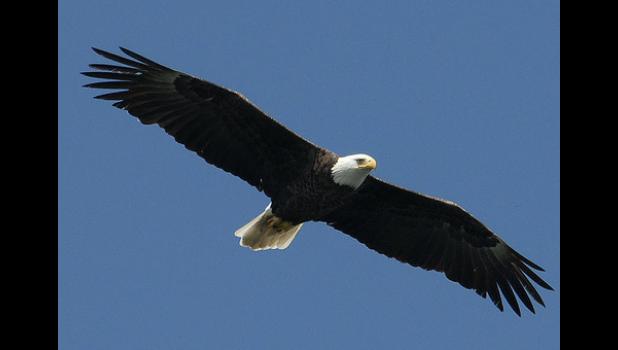The Comeback of the Bald Eagle
It was quiet in the timber. I was sitting in my deer stand overlooking a timbered creek bottom just before dusk when I saw the big bird coming. Almost silently, the mature bald eagle sailed just over the tree tops above me pumping his six-foot wing span slightly, bee lining for Grindstone Creek to the north. I suspected he was the eagle that normally roosted there in a big cottonwood by a riffle. I watched him sail out of sight and my evening was made, deer or no deer.
When America adopted the bald eagle as the national symbol in 1782, the country may have had as many as 100,000 nesting eagles. The first major decline of the species probably began in the mid to late 1800’s, coinciding with the decline of waterfowl, shorebirds, and other eagle prey. During the settlement of the continent, the birds were also shot by farmers as they sometimes preyed on chickens or small livestock.
In 1940, noting that the species was “threatened with extinction”, Congress passed the Bald Eagle protection Act, which prohibited the killing, selling or possessing of bald eagles or their parts. The act was amended in 1962 to include Golden Eagles and the law became known as the Bald and Golden Eagle Protection Act. By 1963, there were only 487 know active bald eagle nests in the lower 48 states. Eagles were being adversely affected by DDT, an insecticide that came into use after WWII, and were dying from lead shot ingested when they fed on injured and dead waterfowl. DDT was affecting the strength of their egg shells, and the lead shot was poisoning them.
After the controversial ban on DDT and the curtailment of lead shot used by waterfowl hunters, eagle numbers began to rebound. In 1978, the US Fish and Wildlife listed the Bald eagle on the endangered species list in the lower 48 states, with the exception of Michigan, Minnesota, Oregon, Washington, and Wisconsin where it was designated as threatened. Bald eagles began to recover with the assistance of protection, captive breeding programs, reintroduction efforts and nest site protection during the breeding season.
By 1995 the USF&WL service adjusted the status of eagles to “threatened” in the lower 48. In the summer of 2007, there were 9,789 nesting pairs of Bald Eagles in the lower 48 states. On June 28, 2007 the Bald Eagle was removed from the endangered species list, making the Bald Eagle an Endangered Species Act success story. Today Bald Eagles are protected under the Migratory Bird Treaty Act and by the Bald and Golden Eagle Act, but they have come back from the brink. The rapid construction of thousands of wind turbines across the United States now presents a new challenge for these majestic birds. Hopefully the 2000 or so birds spending the winter in Missouri this year will fare well. Watching them turn gracefully, high in the winter sky never gets old.

